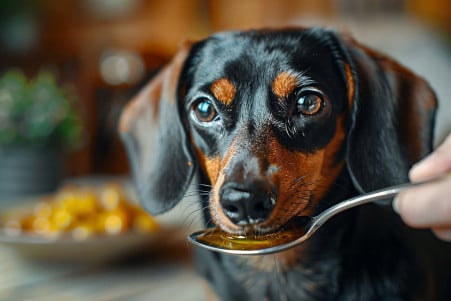Can Dogs Eat Green Olives? Potential Risks Explored
8 May 2024 • Updated 8 May 2024

From potential health risks to digestive issues, it's important to understand the implications of feeding green olives to your canine companion. While not toxic, green olives are high in salt which can lead to excessive thirst, sodium poisoning, and pancreatitis in dogs. They also contain pits that are a choking hazard. It's best to avoid feeding green olives to dogs and stick to dog-safe fruits and vegetables instead.
To fully evaluate the safety of giving green olives to dogs, we'll examine detailed findings from veterinary nutritionists, pet poison control databases, and published case studies. This research will shed light on the specific components in green olives that could potentially harm dogs, as well as provide guidance on appropriate portion sizes and safer alternatives to incorporate into your pup's diet.
Can dogs eat green olives?
Risks of Olive Pits for Dogs
Olive pits are a major choking hazard, especially for small dogs. According to The Native Pet, they can also crack teeth or cause other dental issues if bitten into. Even if swallowed whole, multiple pits can cause an intestinal blockage, which is a life-threatening emergency, according to the Merck Veterinary Manual.
If your dog eats olive pits, be on the lookout for symptoms of a blockage, such as lethargy and a tender abdomen. While one pit may pass through your dog's system without causing any problems, as one vet mentioned on GoldenRetrieverForums.com, JustAnswer.com explains that eating several pits can cause mild stomach upset and may require the dog to have its stomach pumped. To prevent choking, dental, and gastrointestinal issues, make sure to remove the pits from olives before feeding them to your dog or stick to pitted olives.
High Sodium Levels in Green Olives
Green olives are often high in sodium, which can cause increased thirst, sodium poisoning, and other potential health problems for dogs. As noted by The Dog People, symptoms of sodium poisoning can include vomiting, diarrhea, lethargy, and in more serious cases, seizures or coma. The Healthy Dog Co. also notes that dogs with preexisting health conditions like kidney or heart problems are more likely to experience negative side effects from high sodium levels.
As pointed out by Dogster, it’s important to make sure that dogs are only given a small amount of green olives and that they have access to water to prevent dehydration. This is especially important because of the high sodium levels in green olives. It’s important to make sure that green olives are given to dogs in moderation to avoid the potential side effects of high sodium levels.
Are There Any Health Benefits to Feeding Green Olives to Dogs?
Green olives are high in antioxidants, monounsaturated fats, and other vitamins and minerals, so there are some potential health benefits to feeding them to dogs. Texas Hill Country Olive Co. notes that the antioxidants in green olives can help boost the immune system and protect cells from damage, while the fats in olives can help dogs maintain healthy skin and a glossy coat.
That said, the health benefits of giving green olives to dogs are outweighed by the potential risks, as noted by Pure Pet Food and Spot®. There are other, safer, and more nutritious options for getting these nutrients into a dog's diet.
Healthier Alternatives to Green Olives for Dogs
Because green olives should only be given to dogs in small amounts, there are other, healthier options that you can give your dog. According to Daily Paws, fresh fruits like blueberries, apples, and bananas offer antioxidants and fiber without the potential risks of olives.
PetMD also recommends vegetables like carrots, green beans, and sweet potatoes as good sources of vitamins and minerals for dogs. In addition, healthy dog treats, like freeze-dried meat or fish treats, can be a healthier, more balanced option.
Olive Oil: A Healthier Alternative for Dogs?
Although whole green olives may not be the healthiest option for dogs, olive oil can be a healthy and safe addition to a dog's diet if used in moderation. According to Texas Hill Country Olive Co., olive oil contains monounsaturated fats, antioxidants, and vitamins that can help improve skin and coat health, digestion, and overall health. BeChewy explains that the monounsaturated fats in olive oil contain anti-inflammatory properties that can help soothe itchy skin caused by allergies, and the natural laxative effects of olive oil can help dogs who are constipated.
That said, as pointed out by The Dog People and Brightland, overconsumption of olive oil can lead to weight gain, pancreatitis, and gastrointestinal issues in dogs. It's important to work with a vet to determine the right amount of olive oil to add to a dog's diet based on their weight, age, and health status.
How to Tell If Your Dog Is Having an Olive-Related Health Problem
If your dog has eaten a large number of green olives or olive pits, it's important to keep an eye out for any signs of illness or discomfort. According to Sundays for Dogs, if your dog is experiencing vomiting, diarrhea, lethargy, abdominal pain, and has pale gums, you should seek medical attention immediately.
When it comes to olive pit ingestion or sodium toxicity, acting quickly and seeking medical help can help prevent more serious issues, according to JustAnswer.com. The PetMD and PetMD articles also go into more detail about the signs that warrant a trip to the emergency vet.
It's always best to play it safe and contact a vet if you notice any concerning symptoms after your dog has eaten olives or olive oil. Catching any issues early can help prevent more serious problems.
Conclusion: Feed Olives to Dogs in Moderation
Although green olives are not poisonous to dogs, they should still be given in moderation because of the risks associated with their high salt content and the pits. Olive oil is a safer option for adding olives to a dog's diet because it offers some of the same benefits without the choking hazard.
That said, it's important to talk to a vet to make sure you're giving your dog the right amount and to watch for any negative side effects. That said, there are many other options that are safer and healthier for dogs, including fresh fruits and vegetables and dog treats.


